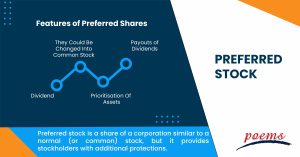Preferred Stock
Table of Contents
What is a preferred stock?
Preferred stock is a share of a corporation similar to a normal (or common) stock, but it provides stockholders with additional protections. For instance, preferred stock investors have priority over regular stockholders where dividend payments are concerned.
Preferred stockholders are also ranked higher in the capital structure of the firm, meaning they will be paid out before common shareholders in the event of a liquidation. Therefore, preferred stocks are typically seen as less risky than regular stocks, but riskier than bonds.
Preferred stock example
Corporation X is a fledgling company seeking funding. It issues 10,000 shares, 1,000 of which are preferred. Investor Y acquires 200 preferred shares. As long as the firm is profitable, she may sit back and wait for dividends to start coming in, generating a steady income.
How preferred stocks work
Despite the fact that preferred stock and ordinary stock share a name, they are radically different in terms of risk and return.
In a number of respects, preferred stocks behave more like bonds, which are fixed-income investments.
Typically, preferred stocks provide set dividends on a predetermined timetable.
Similar to other fixed-income assets, preferred stocks may react to changes in interest rates.
Similar to bonds, preferred shares have a “par value” at which they can be redeemed, which is normally $25 per share. And both may be repurchased, or “called”, by the issuer after a predetermined time period, often five years.
Preferred stock vs common stock vs bonds
Preferred stocks are a great option for people wanting a regular income with a bigger payment than they would receive from dividends on common stock or bonds. However, they do not provide the unlimited upward potential of ordinary stocks and the security of bonds.
Typically, a corporation offers preferred stock for many of the same reasons it issues bonds, and investors like preferred stock for comparable reasons. Without issuing more expensive ordinary stock, preferred stock and bonds are advantageous alternatives for a firm to obtain capital. Investors like preferred stock because this form of stock often offers a greater yield than the bonds of a corporation.
Consequently, if preferred stocks offer a larger dividend yield, why wouldn’t investors always purchase them over bonds? The quick answer is that preferred stock carries greater risk than bonds.
Here are some the risk-based distinctions between asset classes.
Bonds: Investing in a publicly listed firm through bonds is often the most secure option for investors. Legally, interest payments on bonds must precede dividends on preferred and ordinary stock. In the event of a corporate liquidation, bondholders would be paid first, assuming any remaining funds exist. Bonds are low-risk and low-reward investments because investors are ready to accept a lower interest rate in exchange for safety.
Preferred stock: In exchange for a bigger dividend, owners are ready to take a position behind bonds but ahead of common stock. (The basis of the term “preferred stock” is their preference over common stock.) As soon as bondholders have received their dividends, preferred shareholders may collect theirs. A firm might sometimes not make dividend payments, which increases risk. Therefore, preferred stocks have a little higher dividend yield in exchange for a slightly higher risk, but their potential return is often limited to the dividend yield
Common stock: At the end of the payout line are common stockholders, who will get a payout only if the corporation is paying a dividend and everyone before them has got their entire payout. In the case of a company’s bankruptcy-related liquidation, these investors receive the remaining assets after bondholders and preferred stockholders are compensated in full. In contrast to bonds and preferred stocks, however, a common stockholder’s gains are not capped if the firm is successful.
How to buy preferred stock
The fact that preferred equities are traded on the same exchanges as regular stocks gives price transparency. However, as a majority of corporations do not issue preferred shares, the market for them is very small and liquidity might be constrained. Banks, insurance firms, utilities, and real estate investment trusts are the most common issuers of preferred stock.
You may need to evaluate many offerings from companies that issue preferred shares. Typically, a single issuer will offer a variety of preferred securities with varying yields. Prior to acquiring preferreds, an investor can study Moody’s or S&P’s credit rating for each issue and weigh it with other characteristics, such as yields, callability, and convertibility.
You can acquire preferreds in any brokerage account, but remember that their ticker symbols will differ from their common stock counterparts. Verify all of the information to confirm that you are ordering the desired product.
Features of Preferred Shares

- They Could Be Changed Into Common Stock
Converting preference shares to ordinary stock is straightforward. If a shareholder desires to alter his or her holdings, they are changed into a set number of preference stocks.
Some preference shares advise investors that they can be converted beyond a certain date, while others may require authorization and approval from the board of directors in order to be converted.
- Payouts of Dividends
Preference shares let investors get dividends when other stockholders may receive dividends later or not at all.
- Dividend
When it comes to dividends, preference shareholders enjoy a significant advantage over equity and other shareholders since they get dividends first.
Voting Rights Preference shareholders are entitled to the right to vote in the case of extraordinary occurrences. However, only in specific instances does this occur. In most cases, acquiring a company’s stock does not confer voting rights on the company’s management.
- Prioritisation Of Assets
Preferred shareholders have priority over common shareholders when negotiating a company’s assets in the event of liquidation.
Types of Preferred Stock
There are nine categories of preference shares:
- Redeemable Preference Shares
- Non-Redeemable Preference Shares
- Participating Preference Shares
- Non-Participating Preference Shares
- Convertible Preference Shares
- Non-Convertible Preference Shares
- Cumulative Preference Shares
- Non-Cumulative Preference Shares
- Adjustable Preference Shares
Benefits of Preferred Stock
From the perspective of an investor, there are a number of advantages to investing in preferred shares:
- Priority Payments: It is crucial to understand that favored shareholders receive priority payments. Due to the structure of the financial instrument, priority shareholders must be paid before common stockholders. These priority payments effectively ensure coupon payments at a greater rate until the firm has cash flow difficulties and is on the verge of bankruptcy.
- Lower Default Risk: Preferred shareholders are regarded as senior in the debt structure of the company. This means that in the unfortunate case of dissolution or liquidation, preferred shareholders will have a greater claim than equity stockholders. This indicates that the risk of default associated with preferred shares is substantially lower than the risk associated with common shares.
- Tax Advantages: In the United States, the income from preferred shares has a favorable tax status. The tax code enumerates specific types of preferred stock. The dividend for these shares is taxed at a rate much lower than the standard income tax rate.
Disadvantages of preferred shares
There are a number of downsides associated with preferred stock transactions, despite the fact that preferred shares are typically regarded as a safe choice. Some of these drawbacks are described here.
- First, preferred shares are considered significantly differently from bond investments due to the risk of dividend deferral. In the case of bond investments, investors must consider the risk of default. But other issues must be considered with preferred shares. For instance, the issuer may be unable to make dividend payments in a given year and may be required to delay such payments. In such circumstances, preference share owners have no recourse and must give up the dividend payout for that year. Therefore, investors cannot rely only on dividend payouts.
- No Claim to the Firm: The preference shareholders have no actual claim on the corporation. This signifies that their claim is not backed by any particular asset. Instead, they will be compensated only if there is any value remaining after all senior creditors have been paid. Only in the event of the company’s collapse are they ranked above equity stockholders. Consequently, they are somewhat susceptible to the risk of default. This makes preference shares more risky, as their downside is equivalent to that of bonds, but their upside is smaller than that of bonds.
Frequently Asked Questions
On the balance sheet, preferred stock is included in shareholders’ equity. The issuing of preferred shares offers a source of funding. Depending on the kind of preferred stock, such as convertible or non-convertible preferred stock, further classifications are possible.
The call feature is a common characteristic shared by preferred stocks and many bonds. The firm that sold you preferred stock can often, but not always, require the repurchase the shares at a specified price.
Equity includes preferred stock. As with ordinary stock, its shares indicate an ownership interest in a corporation. However, preferred stock often has a set dividend distribution. Thus, preferred stock is sometimes referred to as a bond-like stock.
Investing in preferred stocks rather than debt instruments is primarily motivated by the prospect of higher dividends and dividend yields, as well as capital appreciation.
Preferred stocks see a price increase when interest rates fall and a price decrease when interest rates rise. As interest rates decline, the attractiveness of the dividend yield provided by a preferred stock’s dividend payments increases, causing investors to bid up the stock’s market value.
Bonds and preferred shares tend to underperform common stock. It is also the stock kind with the greatest potential for long-term returns. The value of common stock might rise if a firm performs well. Keep in mind, however, that if the firm performs poorly, so will the stock.
Related Terms
- Payment Date
- Treasury Stock Method
- Reverse stock splits
- Ticker
- Restricted strict unit
- Gordon growth model
- Stock quotes
- Shadow Stock
- Margin stock
- Dedicated Capital
- Whisper stock
- Voting Stock
- Deal Stock
- Microcap stock
- Capital Surplus
- Payment Date
- Treasury Stock Method
- Reverse stock splits
- Ticker
- Restricted strict unit
- Gordon growth model
- Stock quotes
- Shadow Stock
- Margin stock
- Dedicated Capital
- Whisper stock
- Voting Stock
- Deal Stock
- Microcap stock
- Capital Surplus
- Multi-bagger Stocks
- Shopped stock
- Secondary stocks
- Screen stocks
- Quarter stock
- Orphan stock
- One-decision stock
- Repurchase of stock
- Stock market crash
- Half stock
- Stock options
- Stock split
- Foreign exchange markets
- Stock Market
- FAANG stocks
- Unborrowable stock
- Joint-stock company
- Over-the-counter stocks
- Watered stock
- Zero-dividend preferred stock
- Bid price
- Authorised shares
- Auction markets
- Market capitalisation
- Arbitrage
- Market capitalisation rate
- Garbatrage
- Autoregressive
- Stockholder
- Penny stock
- Noncyclical Stocks
- Hybrid Stocks
- Large Cap Stocks
- Mid Cap Stocks
- Common Stock
- Small Cap Stocks
- Earnings Per Share (EPS)
- Diluted Earnings Per Share
- Dividend Yield
- Cyclical Stock
- Blue Chip Stocks
- Averaging Down
Most Popular Terms
Other Terms
- Physical ETF
- Initial Public Offering
- Buyback
- Secondary Sharing
- Bookrunner
- Notional amount
- Negative convexity
- Jumbo pools
- Inverse floater
- Forward Swap
- Underwriting risk
- Reinvestment risk
- Final Maturity Date
- Secondary Market
- Margin Requirement
- Mark-to-market
- Pledged Asset
- Yield Pickup
- Subordinated Debt
- Trailing Stops
- Stochastic Oscillator
- Bullet Bonds
- Basket Trade
- Contrarian Strategy
- Exchange Control
- Notional Value
- Relevant Cost
- Dow Theory
- Speculation
- Stub
- Trading Volume
- Going Long
- Pink sheet stocks
- Rand cost averaging
- Sustainable investment
- Stop-limit sell order
- Economic Bubble
- Ask Price
- Constant prepayment rate
- Covenants
- Stock symbol
- Companion tranche
- Synthetic replication
- Bourse
- Beneficiary
- Witching Hour
- Widow and Orphan stock
- Public Float
- Closing Price
- Quiet period
Know More about
Tools/Educational Resources
Markets Offered by POEMS
Read the Latest Market Journal

Back in Business: The Return of IPOs & Top Traded Counters in March 2024
Start trading on POEMS! Open a free account here! At a glance: Major indices continue...

Weekly Updates 15/4/24 – 19/4/24
This weekly update is designed to help you stay informed and relate economic and company...

From $50 to $100: Unveiling the Impact of Inflation
In recent years, inflation has become a hot topic, evoking strong emotions as the cost...

Japan’s Economic Resurgence: Unveiling the Tailwinds Behind Nikkei 225’s Record Leap
Source: eSignal, Intercontinental Exchange, Inc. In the heart of Japan’s economic landscape, the Nikkei 225...

Weekly Updates 8/4/24 – 12/4/24
This weekly update is designed to help you stay informed and relate economic and...

What Makes Forex Trading Attractive?
In a world where the click of a button can send goods across oceans and...

Weekly Updates 1/4/24 – 5/4/24
This weekly update is designed to help you stay informed and relate economic and company...

How to soar higher with Positive Carry!
As US Fed interest rates are predicted to rise 6 times this year, it’s best...


















